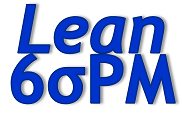How Does Lean Six Sigma Help You Run Cross Functional Programs?
Let’s consider a few typical situations
σ PRODUCING and MARKETING PRODUCTS GLOBALLY:
Global initiatives have become the norm; your PMs need suitable tools in their briefcases to run multi-site and international programs. For example, in my own recent experience (since 2008), I have been responsible for manufacturing products in the U.S., Mexico, Canada, Malaysia, Ireland, China, Costa Rica, Thailand, Japan, India, and I’m probably leaving some out.
Training in the practical application of the right LSS and PM tools will help your Project Managers improve their interactions with global customers and suppliers, moving your company’s PM performance to a higher plane. Better business outcomes follow.
σ MANAGING GLOBAL PROJECTS and TEAMS REMOTELY:
Few project managers in the 21st century are able to work in the same building or even the same city or country with all of their project team members and stakeholders. Face-to-face communication with team members is a rarity.
Developing the professional skills to communicate and share work product across multiple worldwide sites, time zones, cultures, and languages can’t just be assumed; it requires a dedicated focus by your exceptional PMs. Acquire the tools and again, better business outcomes follow.
σ INSPIRING and TEACHING PROJECT CORE TEAMS to BEHAVE as GENERAL MANAGERS:
A team is not just a collection of people who are thrown together and told to make something happen. Professional football teams don’t just take the first eleven people who show up in their uniform jerseys on game day and call them “the team.”
Take a lesson from sports managers and coaches – learn how to consider the skills and toolsets you must have on your cross functional program and project teams, carefully select team members for those attributes and for their ability to work collaboratively and their willingness to learn. Then train them and coach them, continually, forever.
Not easy, and not often done, but very beneficial to your long-term business growth.
σ PRODUCING and MARKETING PRODUCTS GLOBALLY:
Global initiatives have become the norm; your PMs need suitable tools in their briefcases to run multi-site and international programs. For example, in my own recent experience (since 2008), I have been responsible for manufacturing products in the U.S., Mexico, Canada, Malaysia, Ireland, China, Costa Rica, Thailand, Japan, India, and I’m probably leaving some out.
Training in the practical application of the right LSS and PM tools will help your Project Managers improve their interactions with global customers and suppliers, moving your company’s PM performance to a higher plane. Better business outcomes follow.
σ MANAGING GLOBAL PROJECTS and TEAMS REMOTELY:
Few project managers in the 21st century are able to work in the same building or even the same city or country with all of their project team members and stakeholders. Face-to-face communication with team members is a rarity.
Developing the professional skills to communicate and share work product across multiple worldwide sites, time zones, cultures, and languages can’t just be assumed; it requires a dedicated focus by your exceptional PMs. Acquire the tools and again, better business outcomes follow.
σ INSPIRING and TEACHING PROJECT CORE TEAMS to BEHAVE as GENERAL MANAGERS:
A team is not just a collection of people who are thrown together and told to make something happen. Professional football teams don’t just take the first eleven people who show up in their uniform jerseys on game day and call them “the team.”
Take a lesson from sports managers and coaches – learn how to consider the skills and toolsets you must have on your cross functional program and project teams, carefully select team members for those attributes and for their ability to work collaboratively and their willingness to learn. Then train them and coach them, continually, forever.
Not easy, and not often done, but very beneficial to your long-term business growth.

A high performing cross functional program or project team will communicate in a variety of ways. Formal reviews, short conference calls to cover one subject, and daily stand-up meetings such as the one depicted here, all serve to build mutual trust for team members.
LSS PM Experiences in Cross Functional Programs
σ σ COMPUTER PERIPHERALS OEM experienced strong revenue growth for four years after going public. They needed to find ways to continue that growth – to secure more business from existing customers, as well as new markets. Action: Formed cross functional program teams for new product launch, composed of high-potential line managers and senior individual contributors. Gave teams broad latitude to develop and implement (on our own) product roadmaps in various markets – low cost; high capacity and performance; portable products; non-computer applications. We were trained, educated, coached by our senior leaders, and trained some more. Results: The business continued its growth for the next five years plus, becoming #1 or #2 in most key market categories and financial metrics. In the process, several Product Team leaders became company directors and vice presidents, largely attributed to the “general manager” focus of our Product Team experience.
σ σ WORKING in a TIER 1 EMS BUSINESS (Electronics Manufacturing Services). Our largest computer systems customer required global new product launches, using our five EMS plants to provide simultaneous product launch to their respective geos. Action: Established and led dedicated team consisting of one exceptional manager from each site, to be responsible for their site’s launch performance. Daily communication within the EMS cross functional program team and with the customer’s Program Managers throughout development. Held detailed product MRR (Manufacturing Readiness Reviews) with customer, about 3 weeks prior to each new launch. Result: All five sites had production processes, change controls, BOM/ASL/ERP, incoming materials pipeline, outbound fulfillment logistics, and quality systems in place and ready to go before Day 1 of every new product launch.
High-performing cross functional teams bring talented people with different perspectives together to focus on a common goal or two. In doing so, the team members are asked to subordinate their respective functional allegiances to act for the good of the team. At its root, this is what’s meant by ‘behaving as general managers.’ Within the team, therefore, they are not the rep for Engineering, or the rep for Operations, or the rep for Marketing, Finance, Quality, Regulatory, etc., fighting for only their function’s preferences.
An “A-ha!” moment for me, long ago, was when our Engineering teammate acted as if he were merely the functional rep rather than a Product Team General Manager, wanting to add some cool features that would create a delay late in the development cycle. He explained his engineer-centric view by exclaiming, “Our job is to design the most technically advanced product possible!”
The Operations team member (who did embody the GM role) made him see the light. He replied, “No; our job is to develop, launch, and then ramp-up the most technically advanced product we can produce on our schedule, with our targeted profit.” A short dialogue ensued, then we all sang Carole King’s “Where You Lead, I Will Follow” together. (Just kidding on that last part…)
In her recent book, Learning to Lead, Leading to Learn: Lessons from Toyota Leader Isao Yoshino on a Lifetime of Continuous Learning (Integrand Press, 2020), noted business consultant and author Katie Anderson describes the leadership and coaching practices of her long-time mentor, Mr. Isao Yoshino.
I want to share one observation from that book, wherein Mr. Yoshino writes of his approach to working with a U.S. employee assigned to him in Toyota Japan, and Ms. Anderson internalizes his statement. (The employee happened to be John Shook, who later became an author and consultant on lean enterprise and is now Chairman of the Lean Global Network.)
“My [Mr. Yoshino’s] aim as a manager was to develop John by giving him a mission or target, and to support him while
he figured out how to achieve the target. And as I was developing John, I was aware that I was developing myself as well.“In this one statement, Mr. Yoshino summed up what I [Ms. Anderson] consider to be the essence of leadership. Throughout this book, you’ll see [this referred to] as a three-part framework you can commit to in your own work as a leader.
“I believe that great leaders:
Set the direction: Issue a clear challenge, goal, or target for your people.
Provide support: Help your people develop themselves as learners and leaders, and create the systems that enable their success.
Develop yourself: Constantly improve yourself as a leader and a learner.”
Your business’s future is too important to leave to chance. Carefully select your strategic cross functional program and project managers for the traits of the senior leaders you want them to become; that is, develop the behaviors of general managers. Then invest in their ongoing development, and your own, to see to it that they flourish.
Ping me, Dann@Lean6sigmaPM.com, to discuss your situation and issues, and how to employ LSS PM techniques and tools to improve Cross-Functional Programs.
Cross-Functional Program Case Study
Learn from the experience of one high-performing cross functional program manager and his team in an EMS plant who treated a customer complaint not as a nuisance but as a challenge, and rapidly delivered a permanent solution to the customer’s problem.
